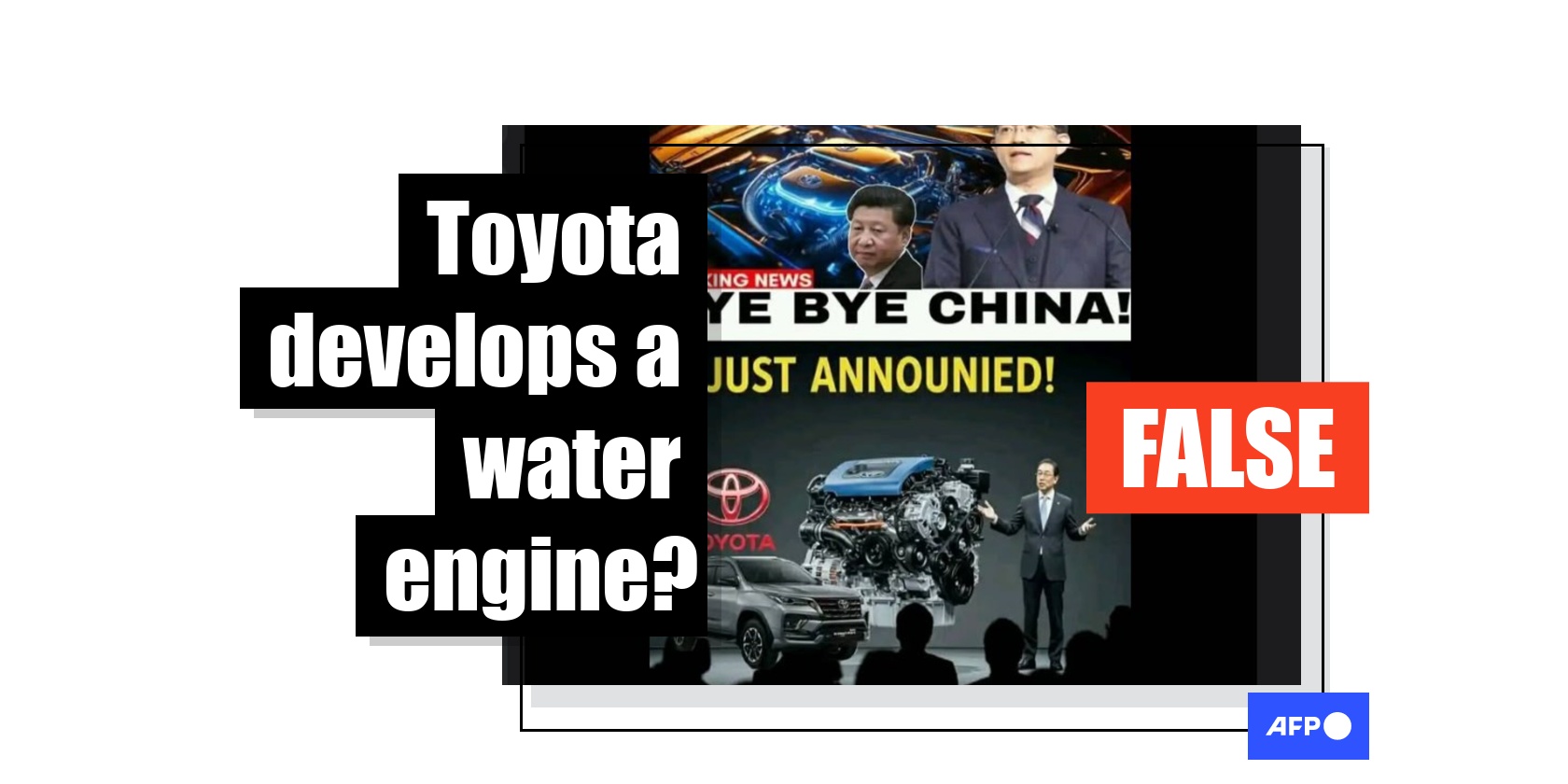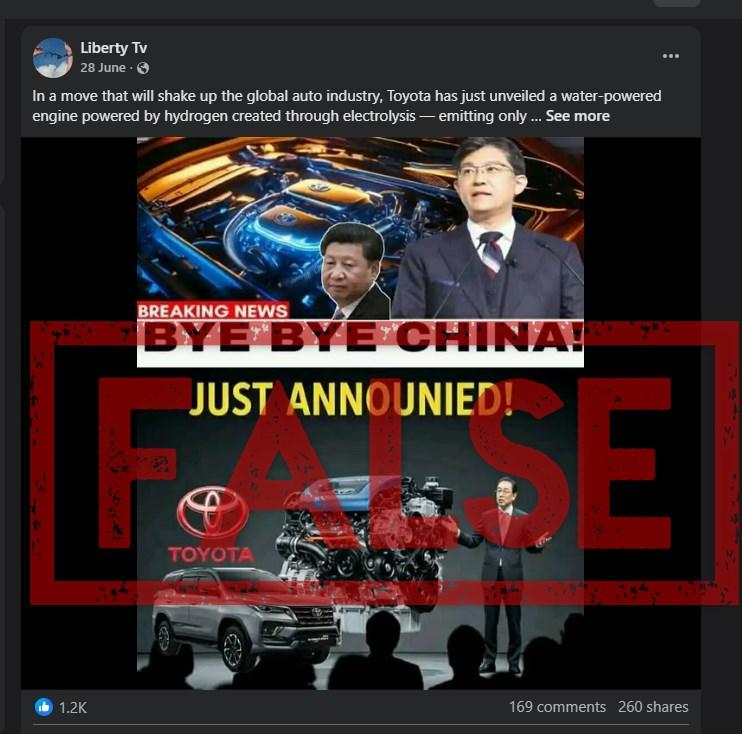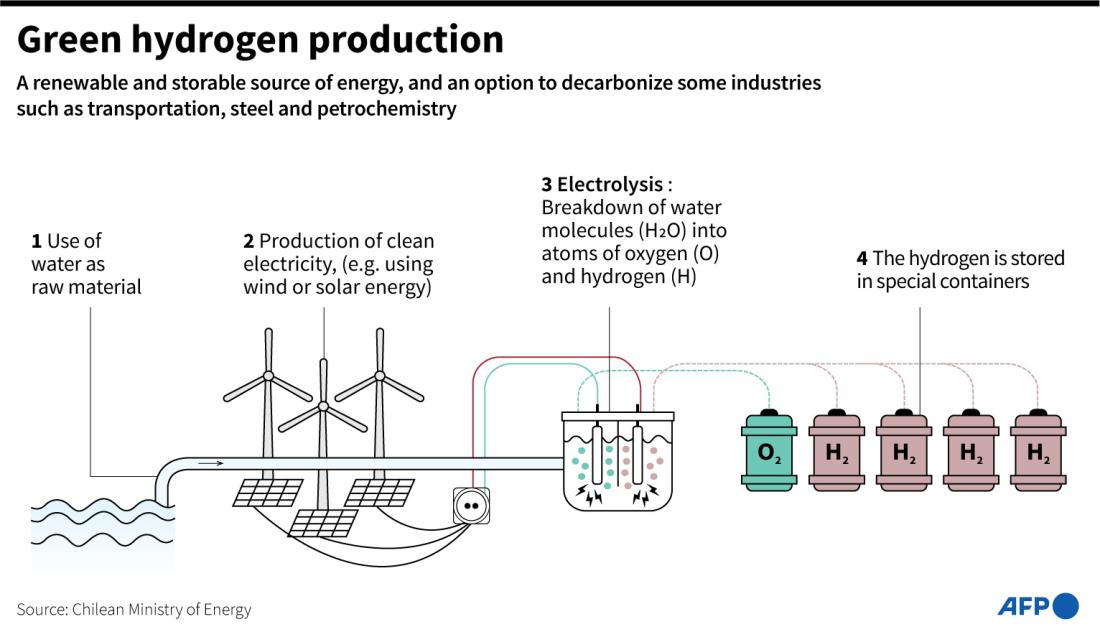
Posts falsely claim Toyota has unveiled a water-powered engine
- Published on August 12, 2025 at 16:00
- 5 min read
- By Bozhidar ANGUELOFF, AFP Bulgaria, AFP Nigeria
- Translation and adaptation Oluseyi AWOJULUGBE
“In a move that will shake up the global auto industry, Toyota has just unveiled a water-powered engine powered by hydrogen created through electrolysis, emitting only water vapor! No lithium. No charging stations…With this bold move, Toyota isn’t just competing with EVs — they’re declaring the end of the battery era,” reads a Facebook post shared more than 250 times since it was published on June 28, 2025.
The post contains a collage of two photos, one showing a man in a suit appearing to present the water engine and the other of a Toyota-branded engine, with a photo of Chinese president Xi Jinping superimposed.

AFP Fact Check debunked similar claims in French and Bulgarian.
In the race for zero-emission vehicles — particularly between electric and hydrogen cars — the hope that water could one day replace fuel is a popular idea that has resurfaced in recent years. But this hypothesis has never been supported by solid scientific evidence, as AFP Fact Check previously explained in this debunk.
The claim that Toyota is developing a water-powered engine is false.
Hydrogen vehicles
Toyota has not made any public announcements "unveiling" a water engine, as the post claimed.
"We are not developing anything that could be described as a 'water engine’," Jean-Yves Jault, a representative of the Toyota Motor Corporation, said in an email to AFP on July 23. Jault called the claims circulating online "false information" and referred to a Forbes article that refutes the rumor (archived here).
Toyota produces vehicles that use hydrogen as fuel. These cars, like the Mirai model, are fueled at specialised stations and equipped with lithium-ion batteries to store and manage energy (archived here).
Robert Rapier, a chemical engineer and the author of the Forbes article, explained that "water as the power source for a vehicle is nonsense”.
“Although water can be an energy source, it is not a fuel. Water is actually the combustion product of hydrogen, which is a fuel. Water is produced when hydrogen is burned. Water can function as an energy source in some situations,” he added.
Electrolysis process
Electrolysis is a process where an electric current is passed through a substance to trigger a chemical reaction, splitting water molecules (H₂O) into hydrogen (H₂) and oxygen (O₂). The process requires a significant amount of electricity and is only effective when there is a stable energy source (archived here).
Electrolysis does not produce energy; it consumes it to produce hydrogen, which is then used to power fuel-cell vehicles. Therefore, there must be a source of electricity, such as a battery, for electrolysis to work inside a car engine.
“But such a scenario would be inefficient, because each energy conversion stage involves efficiency losses. That’s basic thermodynamics. Rather than use a battery to produce hydrogen via electrolysis, which then has to be converted into energy to power a car, it would be far more efficient (and practical) just to use the initial electricity directly without the conversion steps,” Rapier wrote in his article.

Several experts also confirmed this process to AFP Fact Check. Professor Plamen Punov of Sofia Technical University, who supervises student projects on hydrogen fuel cells, noted that the hydrogen used as fuel is not produced directly inside the vehicle (archived here).
“All these cars produce electricity in fuel cells that use pure hydrogen, pre-charged in bottles. I am not aware of such a vehicle existing, and theoretically it would be extremely inefficient and impractical," he wrote in an email to AFP Fact Check on July 7, 2025.
Professor Boriana Tsaneva, a PhD in chemistry at the same university, also confirmed to AFP Fact Check via email that “it is technically possible to use electrolysis to harness the residual energy of a moving vehicle”, but this option is “economically unreasonable”.
Aside from the high costs and additional weight from installing an electrolysis cell and other components on board, Tsaneva added that the explosive gas mixture produced would be incredibly dangerous. This mixture cannot be stored safely and needs to be added immediately after production, she noted. Furthermore, the usable energy produced from burning the gas mixture is negligible.
Water as coolant, not fuel
The confusion likely stems from a patent filed by Toyota in 2023 for a hydrogen engine with a water-cooled system. In this design, water is used as a coolant instead of the traditionally used air, not as a fuel (archived here).
This system better controls the high temperatures created by hydrogen combustion. By lowering temperatures, manufacturers can use lighter materials in the combustion chambers and cylinders, thus improving engine efficiency and reducing weight.
The Toyota Mirai follows the manufacturer’s current technology: a hydrogen fuel cell that generates electricity to power an electric motor (archived here). Hydrogen is stored in reservoirs under high pressure, and the vehicle is recharged at specialised stations. The only byproduct of converting hydrogen into electricity is water vapour. The car does not have an electrolysis system to produce hydrogen from water. It is equipped with a lithium-ion battery.
Toyota also uses electrolysis to produce hydrogen at some of its facilities, but this process takes place outside the vehicles, not inside them (archived here).
As part of a long-term strategy toward carbon-neutral vehicles, Toyota is taking a multi-pronged approach. This includes the development of hydrogen fuel cells, hydrogen-powered combustion engines, and solid-state batteries, which could offer better performance for safety, range and power (archived here).
Battery-powered electric vehicles dominate the zero-emission transport market, due to their affordability, higher fuel efficiency, and growing charging infrastructure (archived here).
However, some automakers, including Toyota, are considering hydrogen-powered cars as a complementary solution for heavy-duty transportation and long-distance travel. Their large-scale development remains limited by high production costs and a still-underdeveloped refuelling network.
Most analysts agree that the future of zero-emission mobility will rely on a mix of technologies: Batteries will remain the preferred option for passenger cars, while hydrogen could play a strategic role in specific sectors, such as long-haul trucks, heavy-duty vehicles and certain industrial uses (archived here).
AFP has debunked other claims about the existence of water-powered cars here and here.
Copyright © AFP 2017-2026. Any commercial use of this content requires a subscription. Click here to find out more.
Is there content that you would like AFP to fact-check? Get in touch.
Contact us
